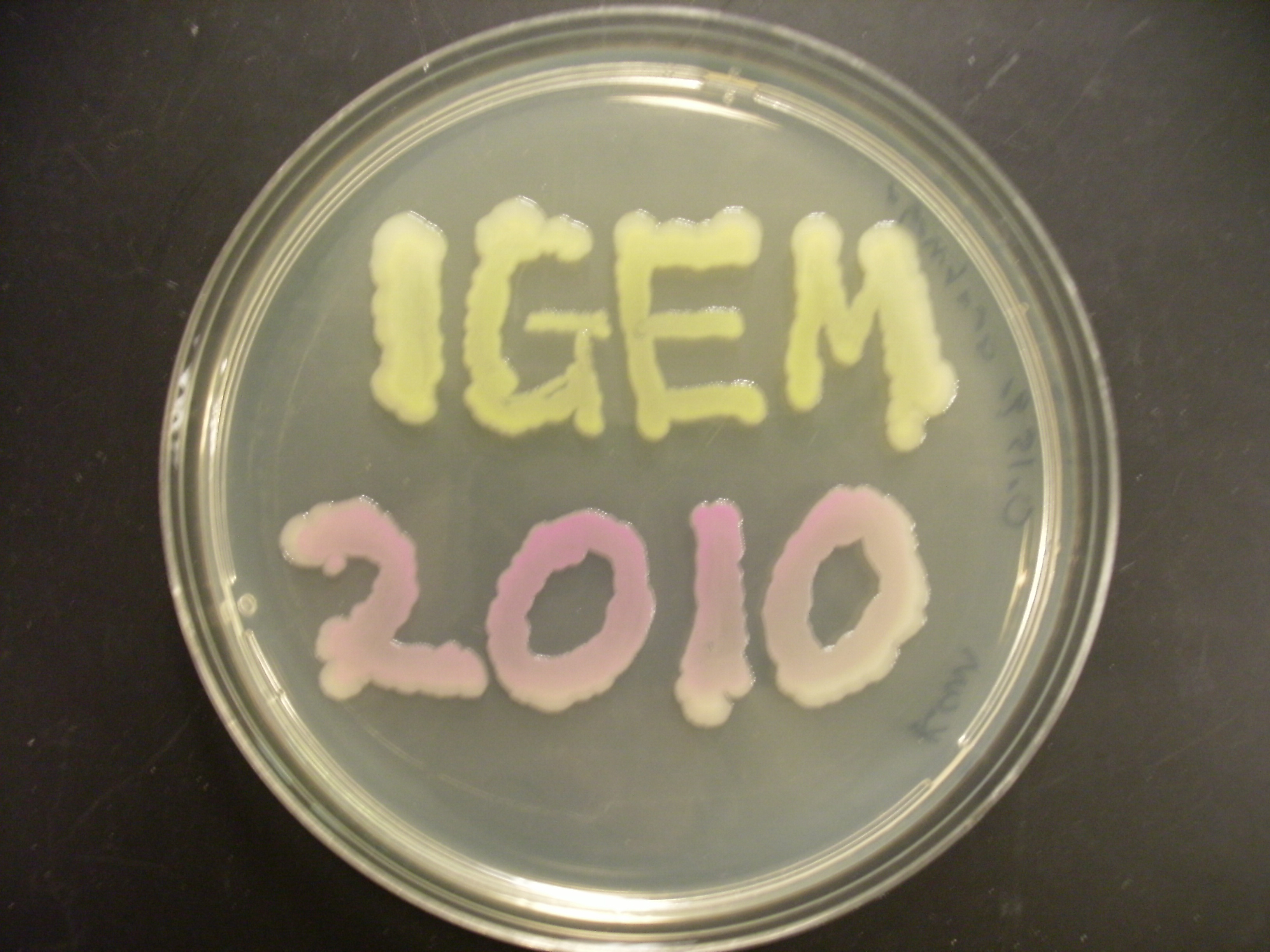Team:Michigan
From 2010.igem.org
Chillywings (Talk | contribs) |
Chillywings (Talk | contribs) (→Project Background) |
||
| Line 6: | Line 6: | ||
| | | | ||
| - | + | Our team worked on two projects simultaneously this year: The Hy-Bi project and the Oil Sands Initiative: | |
| - | + | '''Hy-Bi''' | |
| + | The Hy-Bi project is in association with the Chemical Engineering department’s joint project to produce hydrocarbons from algae biomass, dubbed "Hy-Bi"[1,2]. This consists of hydrothermal processing of the algae followed by catalytic upgrading of the “bio crude” oil. Before the hydrothermal processing can take place the algae needs to be concentrated from 1 to 10 g/L to over 250 g/L. Traditional methods that are used like centrifugation, filtration and chemical flocculation are costly. We propose creating a bioflocculation circuit in ''Escherichia coli'' to flocculate the algae as an alternative option. This consists of a “trigger” for flocculation which would then express proteins that cause the surface of the ''E. coli'' cells to become sticky and flocculate with the algae. | ||
| - | + | '''Oil Sands''' | |
| - | 2. Paslawski J, Nemati M, Hill G, Headley J. Biodegradation kinetics of trans -4-methyl-1-cyclohexane carboxylic acid in continuously stirred tank and immobilized cell bioreactors. Journal of Chemical Technology & Biotechnology. 2009;84(7):992-1000. Available at: http://doi.wiley.com/10.1002/jctb.2122. | + | Our team will also be working on the [[Oil Sands]] Initiative simultaneously. Tailings ponds have become a major ecological concern regarding oil sands operations due to the toxicity of the water. The main cause of toxicity in tailings water has been identified as naphthenic acids (NAs), and thus our strategy will be to these break these organic molecules down via bioremediation to expedite the reclamation process. Two bacteria, ''Pseudomonas fluorescens'' and ''Pseudomonas putida'', were isolated from tailings pond sediments and found to be capable of synergistically degrading >95% of a commercial mixture of NAs resembling those found in the tailings water over a 4 week period [3]. In addition, two other bacteria have shown degradation efficiencies near 100% when in an immobilized cell reactor (ICR)[4], which functionally represents a biofilm. Following these findings, the strategy we wish to implement will be to utilize the two naturally adapted ''Pseudomonas'' species and genetically engineer them to optimize their biofilm formation abilities in tailings pond water-like conditions. This would allow for easier and improved use in an ICR. Alternatively, a more organic and aesthetically pleasing method would be to create a large 'slide' or 'washboard', where the naturally adapted ''Pseudomonas'' species would grow under a constant stream of tailings water, and function similar to an ICR. |
| + | |||
| + | |||
| + | 1. http://www.nsf.gov/awardsearch/showAward.do?AwardNumber=0937992<br> | ||
| + | 2. http://che.engin.umich.edu/news/savagemakeoil.html<br> | ||
| + | 3. Del Rio LF, Hadwin a KM, Pinto LJ, MacKinnon MD, Moore MM. Degradation of naphthenic acids by sediment micro-organisms. Journal of applied microbiology. 2006;101(5):1049-61. Available at: http://www.ncbi.nlm.nih.gov/pubmed/17040229.<br> | ||
| + | 4. Paslawski J, Nemati M, Hill G, Headley J. Biodegradation kinetics of trans -4-methyl-1-cyclohexane carboxylic acid in continuously stirred tank and immobilized cell bioreactors. Journal of Chemical Technology & Biotechnology. 2009;84(7):992-1000. Available at: http://doi.wiley.com/10.1002/jctb.2122. | ||
Revision as of 20:49, 26 October 2010
Project Background
|
Our team worked on two projects simultaneously this year: The Hy-Bi project and the Oil Sands Initiative: Hy-Bi The Hy-Bi project is in association with the Chemical Engineering department’s joint project to produce hydrocarbons from algae biomass, dubbed "Hy-Bi"[1,2]. This consists of hydrothermal processing of the algae followed by catalytic upgrading of the “bio crude” oil. Before the hydrothermal processing can take place the algae needs to be concentrated from 1 to 10 g/L to over 250 g/L. Traditional methods that are used like centrifugation, filtration and chemical flocculation are costly. We propose creating a bioflocculation circuit in Escherichia coli to flocculate the algae as an alternative option. This consists of a “trigger” for flocculation which would then express proteins that cause the surface of the E. coli cells to become sticky and flocculate with the algae. Oil Sands Our team will also be working on the Oil Sands Initiative simultaneously. Tailings ponds have become a major ecological concern regarding oil sands operations due to the toxicity of the water. The main cause of toxicity in tailings water has been identified as naphthenic acids (NAs), and thus our strategy will be to these break these organic molecules down via bioremediation to expedite the reclamation process. Two bacteria, Pseudomonas fluorescens and Pseudomonas putida, were isolated from tailings pond sediments and found to be capable of synergistically degrading >95% of a commercial mixture of NAs resembling those found in the tailings water over a 4 week period [3]. In addition, two other bacteria have shown degradation efficiencies near 100% when in an immobilized cell reactor (ICR)[4], which functionally represents a biofilm. Following these findings, the strategy we wish to implement will be to utilize the two naturally adapted Pseudomonas species and genetically engineer them to optimize their biofilm formation abilities in tailings pond water-like conditions. This would allow for easier and improved use in an ICR. Alternatively, a more organic and aesthetically pleasing method would be to create a large 'slide' or 'washboard', where the naturally adapted Pseudomonas species would grow under a constant stream of tailings water, and function similar to an ICR.
|
|
 "
"

